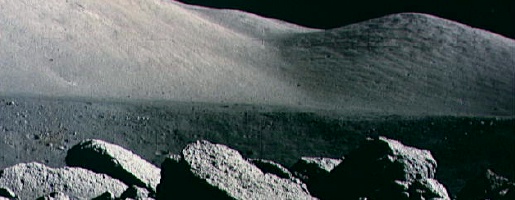 |
|||
|
Apollo 17 panoramic view of Camelot Crater.
|
|||
| THE SURFACE OF THE MOON | |||
| The Moon has a cratered surface, as can be seen through binoculars. The naked eye can also see large darker areas, the "seas", or maria. The heavily cratered areas and the maria are the dominant features of the Moon. | |||
| Impact craters | |||
| The Moon has a wide variety of craters in a complete range of sizes, which have been formed over a long period of time. The cratering rate today is far lower than during the early days of the Solar System. Nevertheless, the number of craters per unit area is a good indication of the relative ages of lunar features. | |||
| More about the Moon's craters | |||
| Maria - the Moon's seas | |||
| Maria are the dark regions on the Moon which make the familiar face of the "man in the Moon". Though they are quite obvious from Earth, they only cover 15% of the lunar surface as there are no large maria on the far side. | |||
| Maria are low-lying volcanic plains. Most of them fill the large circular basins made by impacts. It used to be thought that the mare resulted from melting caused by the impact itself. Volcanic lavas merely fill the basin left by the impact, able to travel up through the shattered crust more easily. There are two kinds of maria, "irregular", which are shapeless and include Oceanus Procellarum and Mare Frigoris, and "regular", which are roughly circular like Mare Crisium and Mare Humorum. The regular maria are impact basins which have been flooded with molten lava, erupting from vents which are now buried. | |||
| Is it only coincidence that there are so few maria on the farside? There are large impact basins on the farside, but they are not all filled with lava. The most likely explanation is that the thick crust makes it harder for magma to get to the surface. The Moon's crust is thinner on the nearside. Like Mars, the Moon's centre of mass is offset. This is because the Moon's mass has been concentrated by the pull of the Earth on the nearside. As a result the lighter elements, more abundant on the farside, have formed a thicker crust. | |||
| Laboratory analysis of mare rocks shows a wide range of dates, but they generally formed between 3.0 and 3.8 thousand million years ago. Some of the maria are much younger, perhaps as young as 1 thousand million years old, because there are patches of lava which overlie young craters and therefore were put down afterwards. | |||
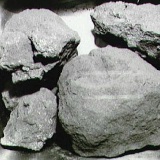 Rocks from Mare Tranquilitatis brought back to Earth by Apollo 11. |
|||
| One particularly distinctive landform in the maria are wrinkle ridges. These are like the ones on Venus, quite crooked looking. They are wider and more complex than those on Venus. They can run for long distances but most are broken along their length. Sometimes they form arcs. Such curved ridges are sometimes seen in the maria of circular impact basins. These appear to have been formed by compression of the surface. As the mare cooled it contracted, buckled the surface, and created these concentric ridges. | |||
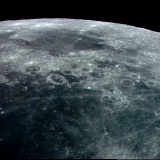 Apollo 16 view across Oceanus Procellarum towards Mare Humorum. |
|||
| Although volcanism was dominated by the flooding which formed the mare, there are some volcanic cones in the Marius Hills region of Oceanus Procellarum; erupting on top of the mare. They are fairly small, under 300 metres high and just 3 kilometres across. They resemble terrestrial cinder cones, which form by ash piling up to form a conical edifice. Although they are cone shaped in profile, when seen from above they are horse-shoe shaped. Part of the volcano appears to have collapsed and lava erupted from the side, similar to the eruption from Mount St. Helens on Earth which left the mountain a distinctive horse-shoe shape. | |||
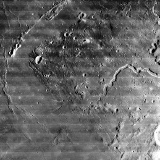 Lunar Orbiter 4 view of the volcanic cones in the Marius Hills in Oceanus Procellarum. |
|||
| Highlands | |||
| The bright looking areas of the Moon are called the highlands or "terrae". They are very heavily cratered and therefore represent the oldest surfaces on the Moon. Some samples of highland material returned to Earth for analysis are 4.3 thousand million years old | |||
 Breccia rock sample from the lunar highlands, brought back to Earth by Apollo 16. |
|||
| Terrae are not evenly distributed - the farside of the Moon consists solely of highlands. On the nearside, it is the southeast quadrant which is given over to the highlands. They have a height of about 5 kilometres above the average lunar surface level, but this varies a great deal. | |||
| They are not formed in the way mountains on Earth are, by compression, folding and faulting. They are high up because they formed from chunks of low density material, which could float above the denser molten rocks when the Moon was evolving into a layered body. The terrae are dominated by rocks named anorthosites which are basalts (volcanic rocks) rich in calcium and aluminium. There are other types of rock including breccias which are re-formed from fragments of crust smashed by meteorite impacts. Some of the breccias have been smashed and re-formed more than once. Other rocks found in the lunar highlands include fine grained materials formed by impacts which melted the surrounding surfaces. | |||
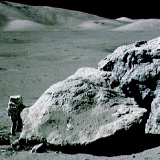 Rock samples from the lunar highlands, collected here by Apollo 17 astronaut Harrison H. Schmitt, are dominated by basalts. |
|||
| Rilles | |||
| Rilles are narrow channels. They are not formed by water as water cannot remain on the Moon's surface as a liquid. There are two types, with very different origins. Linear rilles are straight and are formed by tectonism or earth movement. They are the equivalent to graben on Earth and are generally thought to have formed by extension of the surface. They form when the surface pulls apart and a linear segment drops down forming a trench. | |||
| Sinuous rilles are so called because they meander across the surface, sometimes curving around topographic features like craters and hills. Sinuous rilles are typically 10 to 100 kilometres in length, though the longest is 340 kilometres They range from a few metres wide to 3000 metres across. Some have a bulbous end, so in plan view they sometimes appear tadpole shaped. Rilles appear to lack a source of any kind - they do not start on a volcano or a caldera, but they are thought to have been carved by very runny lava. | |||
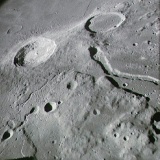 Apollo 15 view of the craters Aristarchus (left), Merodotus, and Schroter's Valley. |
 An oblique view of the rille, Schroter's Valley, as photographed by Apollo 15. |
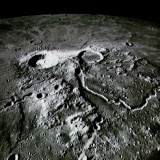 Looking south along Schroter's Valley towards Aristarchus crater. |
|
| Normally lava might be expected to accumulate as it chills and freezes. This would happen if the lava was flowing steadily and gently; this type of flow is called "laminar" (sheet) flow. This allows the lava in contact with the surface to cool and solidify, and it also allows the exposed surface of the flow to freeze, forming a roof. When this happens a lava tube is formed and the lava stream, now insulated, can travel long distances. | |||
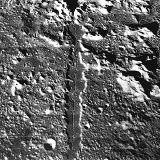 An oblique view from Lunar Orbiter 5 of the Alpine Valley, a sinuous rille. |
|||
| To form an open channel, however, the lava must be very liquid and flow rapidly and erratically, rather like a mountain torrent. Such a flow is known as "turbulent". This does not allow the surface to freeze over, and because the flow is so hot it probably melts and plucks away some of the surface rocks, mixing them into the flow, cutting the channel deeper. This accounts for the very steep straight sides that sinuous rilles have, and the splashes of rock observed by the Apollo 15 astronauts when they inspected Hadley Rille. | |||
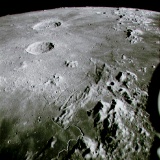 Apollo 15 image of Hadley Rille, running along the left of the Apennine Mountains. |
 Lunar Orbiter 5 image of Hadley Rille, near the Apollo 15 landing site. |
 High resolution view of Hadley Rille, from Lunar Orbiter 5. |
|
 View north along Hadley Rille - Apollo 15 astronaut David Scott is in the foreground. |
|||
| Regolith | |||
| Before Apollo, some authorities suggested that a thick layer of very fine loose sand would not allow a landing on the Moon and that anything trying to put down on the surface would disappear beneath an ocean of soft dust. Measurements made from Earth, though, had used radar to give scientists a good idea of the consistency and depth of the lunar soil and that it was probably safe to land on. | |||
| The lunar surface has an upper layer or "regolith". It is a layer of broken debris and fine rock particles, that overlays the lunar bedrock. The regolith over most of the Moon is 4 to 5 metres deep. It is possibly deeper in highland regions, perhaps 10 metres. It is loose on top but more compact with depth. The compacted rocky soil made it difficult for the astronauts to make even shallow holes when they were drilling the surface to set up experiments. | |||
 Apollo 17 image of Shorty Crater, showing the lunar surface covered with broken debris. |
 Some lunar soil has a distinct orange colour. |
 Apollo 17 astronauts dug below the lunar surface to expose orange soil. |
|
| The very top layer is fine and powdery like cement dust. It is fine grained and cohesive, and retains impressions. This quality gave us one of the most evocative pictures returned to Earth, a human footprint on the Moon. | |||
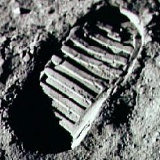 A footprint left by an Apollo 11 astronaut. The lack of erosion processes means that the astronauts' footprints are still there. |
|||
| This fine powdery soil is formed by micrometeorites (tiny meteorites) hitting the surface, breaking rock fragments up into smaller and smaller grains. They stir the lunar soil about, redistributing it. Such a blanket of soil covers most of the Moon's level surfaces. | |||
 One of the smallest lunar craters - a micrometeorite crater in lunar soil at 4850 times actual size. |
 The lunar regolith returned by Apollo 17 contains small pieces (0.03mm) of orange glass over three thousand million years old. |
||
|
|
|||